Supernova: Life Through Death
The explosion of a supernova is the most spectacular, devastating and grandiose phenomenon in the Universe. From these explosions formed the basic chemical elements and all known cosmic bodies: planets, nebulae, black holes, magnetars, asteroids.
Calcium in our bones, iron in blood, magnesium in the muscles- all this were born in the thermonuclear furnaces of stars, In fact, we are born of supernova’s stardust.
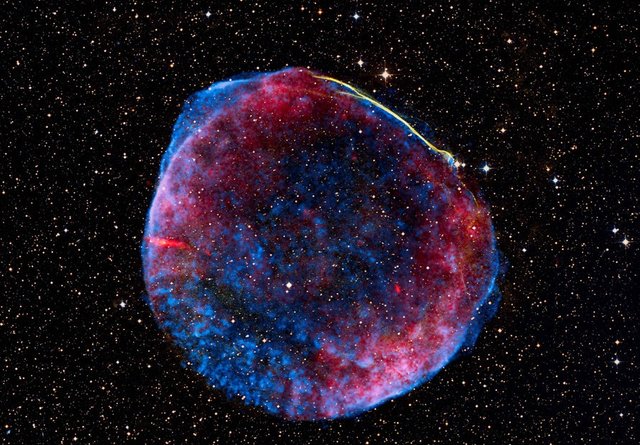
Each star has its own life path, and not all of them are destined to end his existence by an explosion. Many, after a trillion years of burning, will remain the cold stones in the emptiness of space.
A star with a mass 20% more of our Sun, has a high chance to become a supernova. A stars less than 1.4 solar masses are called white dwarfs and will gradually cool. This ratio of masses is called the Chandrasekhar limit.
At the initial stage of the life, a star consists mainly of hydrogen -the most abundant element in the Universe. Hydrogen, by the action of incredible strength of gravity, begins to burn first. This is the beginning of nuclear fusion, which will change the composition of the star and in the future will lead to the explosion.
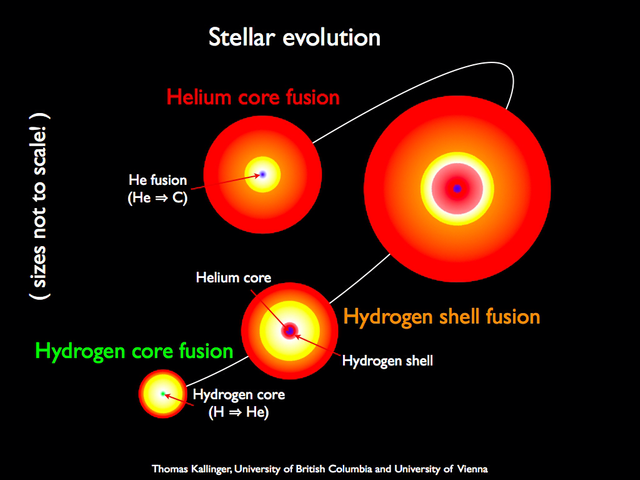
After the star burned all the hydrogen, it greatly increases in size and becomes brighter, now the core consists of a heavier element – helium (it is produced by nuclear fusion of hydrogen), and it becomes a new fuel.
So step by step, over millions of years formed new elements, the each new is heavier than the previous, and takes its place as the main substances for burning in the core of star.
The hydrogen is converted into helium, helium into carbon, carbon into oxygen, oxygen into silicon, silicon into ferrum. Thus, by the time of the explosion the star has a multilayer structure.
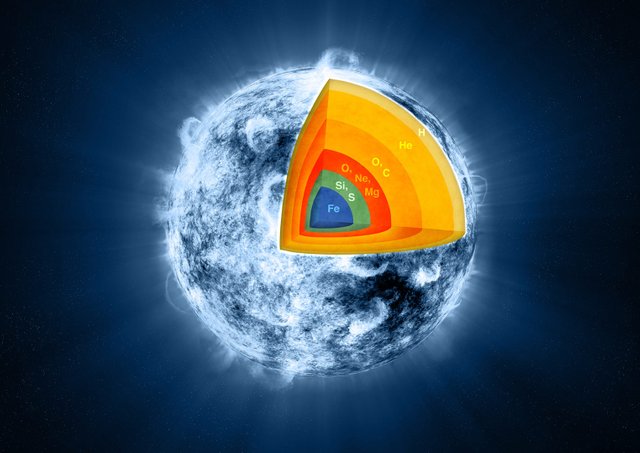
The number of these elements in the star varies significantly, the star consists of 98% helium and hydrogen, while the iron core is only 0.002% of the volume.
After ferrum becomes the main element of the core, begin the process, which will lead to the formation of a supernova. Ferrum, which has a gaseous form at a temperature of billions of degrees, starts to absorb the energy of nuclear fusion.
Before this energy was moving from the inside (core) to the outside, thus opposing the force of gravity through the expansion of the stars. But now the force of gravity becomes stronger and the star starts to shrink, with increasing the temperature in the core.
The density of the ferrum core continues to grow (dice from this ferrum would weigh 10,000 tons). At some point under the influence of gravity the electrons literally are pressed into protons- occurs electronic capture, resulting in the formation of neutrons and neutrinos.
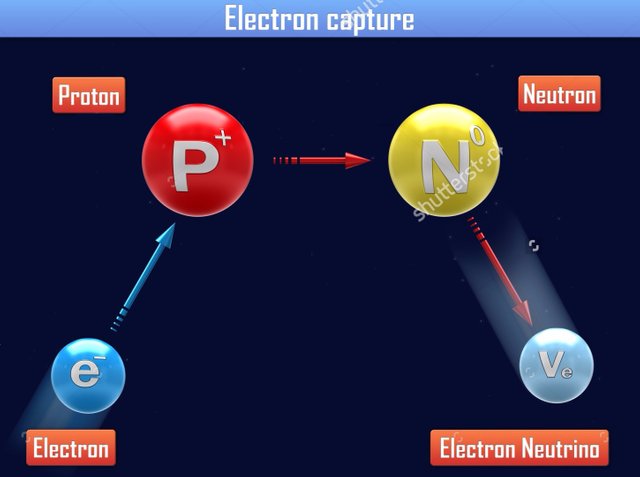
As a result, the core turns into a neutron star. It is so dense, that substances that are attracted from the edges of the star to its center, can't to punch it (the shell of the neutron star) and literally begin bouncing back.
Near the core temperature reaches about 50 billion Kelvin (The temperature of our sun is 15 million Kelvin), the particles bounce off the surface of the core at a speed of 40.000 km/h.
At the same time inside the core, in the formation of neutrons, appear neutrino-particles that seek outside to compensate for the energy of thermonuclear fusion, but they are also unable to break through the shell of the core. The star begins to collapse and explodes in a supernova!
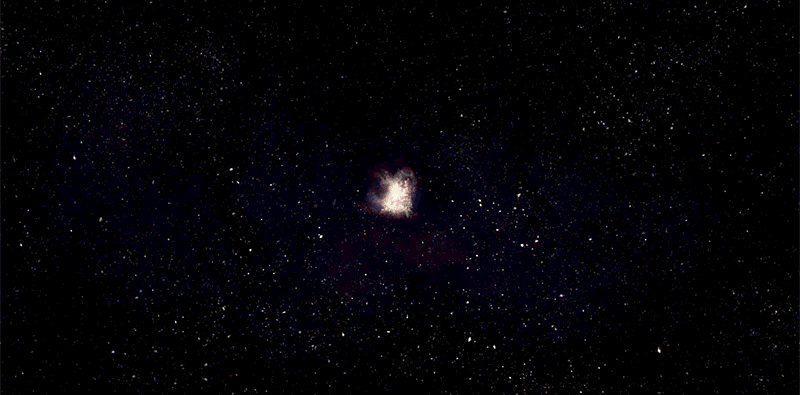
The explosion carries all chemicals that were part of the star, on billions of kilometers around
The explosion is so powerful that free neutrons are literally imprinted in the atomic structure of the iron and change it, thus formed even heavier elements: cobalt, nickel, gold, platinum and uranium. (The active phase of the explosion can last 30 days, it is a brief moment for the Universe. That's why these elements are so rare).
But not all stars disappear after the explosion, some of them leave a corpse, the type of the corpse depends on the size of the star. If the mass of a star 8 times more than the Sun, it leaves a neutron star, if the mass of 20 times more Sun then it leaves a black hole. Also, some supermassive stars turn into a pulsar or a magnetar.
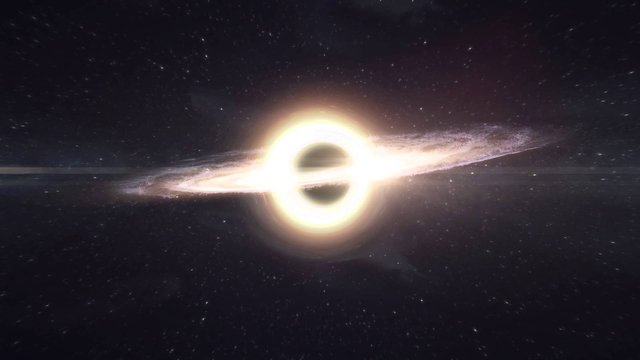
Many believe that in the Universe there is no phenomenon, that could surpass the beauty of supernova explosion. The supernovas can shine brighter than entire galaxies, and destroy all that is in the hundred of light years from them. But they are the source of the matter, including the matter for the development of complex organic life… dying, they give a life.
sources: Supernova WiKi, Nuclear fusion, Electron capture, Chandrasekhar limit, The death of star, Thomas Vance: Supernova vision images from Google search.
There are many 3D models and animation of this process, but I suggest you watch the video where Thomas Vanz modeled a supernova explosion in a closed aquarium by adding fluorescent paints.

Cool post! Just a comment, to make one sentence clearer: electrons and protons are not really 'forming' neutrons. They are reacting and the reaction products are neutrons (and neutrinos). it is not like the neutron being a bound state of a proton and an electron :)
Maybe it would be useful to slightly rewrite this sentence? What do you think?
Thank you. And you are right,
i'm sorry for my english "forming" is maybe wrong word for this process, i just tried to explain it easier. But it is a product of reaction. Would be right to write:
It is actually a weak interaction process. There is a W-boson exchange between the electron and one of the up-quark constituting the proton. Since the W-boson is charged, the electron turned into a neutrino and the up-quark turned into a down-quark.
I wish I could draw a diagram... ;)
well, i think Beta decay deserves a separate post :)
Actually, beta decay works in the other way round :) Here, one inverts it, which is possible as one puts enough energy in the process.
β− decay yes, works in the other way round (neutron into a proton)
but β+ decay turns proton into a neutron. am i wrong?
This process of course differs from the electron capture. But according to scientific articles there is only two versions of the appearance of neutrons in the stars
β+ decay and electronic capture
I'm curious to know your opinion, because you are the man who is directly connected with science (as i think).
A proton cannot decay into a neutron as it is lighter. beta+ decay arise when we are discussing more complex atoms (as in the stars actually). The proton is in contrast stable.
Here, we are really having a reaction or a scattering process of an electron and a proton. It is the same interactions that arise as in a beta decay, but the initial and final state particles are different.
So for supernovas we can't say that it is beta decay in the full sense of this process, but in the same time it looks very similar - something like that?
It is just a matter of what a 'decay' means. Here it is not. A decay is one particle decaying into other particles. Here, we have two initial-state particles.
ok, so it's electronic capture, as i wrote in the begining :)

my mistake that I am not to the place mentioned the beta decay, sorry :)
No it is not electronic capture as the electron is converted into something else. When an ion or atom captures and electron, the electron nature is not altered. We have really here a scattering reaction: the electron turns into a neutrino via weak interactions.
Hello @natord,
It gives us pleasure to inform you that you have been chosen as a featured author by the @robinhoodwhale initiative.
Learn more about the Robinhood Whale here!
If you wish to support this initiative, join the Robinhood Whale voting trail on Streemian. Every vote counts!
We hope to see you continuing to post some great stuff on Steemit!
Good luck!
~RHW~
Thank you for support!
This was a really nice post @natord. Lots of great details, and the visuals really complement things.
Oh, thank you!:) But it can't compete with your articles ;)
I don't know about that :) I think you hold your own.
I mean, your articles I like more than mine :)
I appreciate the complement. I think I am slowly getting better at writing them. Still, your articles are good :) and I enjoy them. I try not to compare my self to others (though it still happens... We are all human), just try to do the best I can, and get better with time.
WOW! @natord
Nice explanation, great post! This has been a fascinating subject to me for a long time.
Thank you. I'm glad that you liked it :)